人教版英语九年级全一册教案:Unit1SectionB(1a-1e)
- 格式:doc
- 大小:101.00 KB
- 文档页数:10

人教版英语九年级全一册教案:Unit1 SectionB(1a-1e)Unit1 SectionB(1a-1e)教案【教材版本与册数】新目标人教版九年级全一册【单元名称】Unit 1 How can we become good learners?【课时】Section B 1a-1e(第4课时)【课型】Listening and Speaking(听说课)【本课时教学设计】教材版本:新目标册数:第5册年级:九年级单元:Unit 1 课型(课时):Section B 1a-1e 听说课第 2 页第 3 页教材分析教学目标教学重难点建议教法教学流程第 4 页教学评价步骤过程措施(教师活动与学生活动)目的持续性评价DELC4 1预备与激活先期知识Step 1GreetingandLeadingin( 3mins )DiscussionDo you have difficulty in learning English?What things are difficult for you?1a Learning English can be difficult. Whatthings are difficult for you? Read the list.Check (✓) the statements that are truefor you.1.利用IQEE策略利用旧的词汇来与本堂课的话题词汇建立起记忆连接。
简单有效的激活学生与此话题相关的背景知识激活学生的前期知识,培养学生良好的预习习惯。
2.真实情景式导入话题,激发学生的学习兴趣1.通过课前的预习,培养学生的“IIQEE”学习策略2.学生利用老师提供的信息对老师进行提问第 5 页DE LC5 2 获取新知识Step2Pre-listening(听前)(5 mins)1a and 1b1.Let’s students read the sentences in1a. Makethem understand these sentences.2. 1b What other things are difficult for you?Make a list.1). I don’t know enough words to write well.2). My pronunciation is not good …1c and 1d复习巩固目标句型,为后续听力做准备和铺垫培养学生听前预测和聚焦关键信息和关注细节问题的听力策略1.通过听力练习,达到语言输入的目部分学生应该能利用此策略获取有效信息.1.学生是否能听懂目第 6 页Step 3 While- listening (听中)(15mins)Listening and speaking1)1c Paul finds it difficult to learn English. Listenand complete .Answers: pronunciation, forgets, understand2) 1d Listen again. Complete the solutions.3) listen again and read after it.Answers: Listening ,write the new words, join anEnglish club, pen pal的。
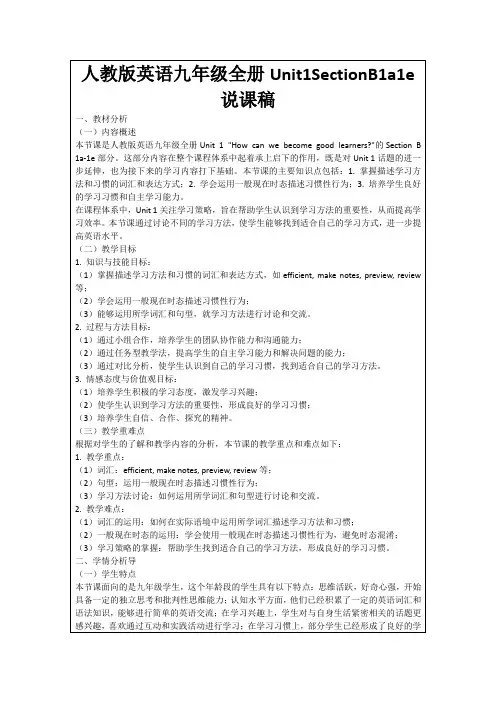
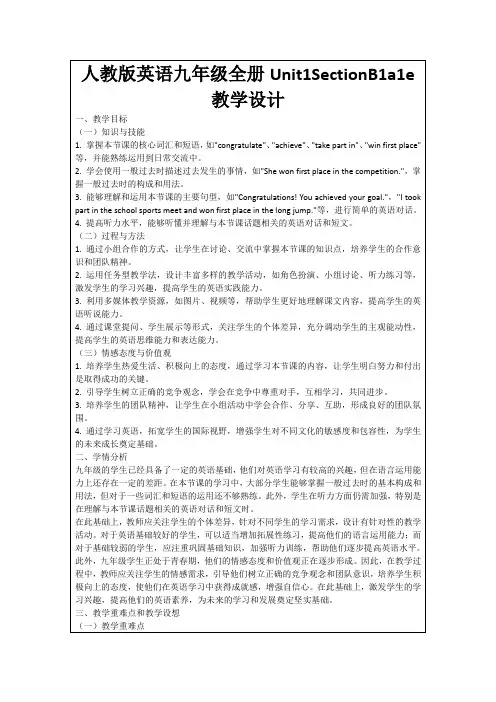
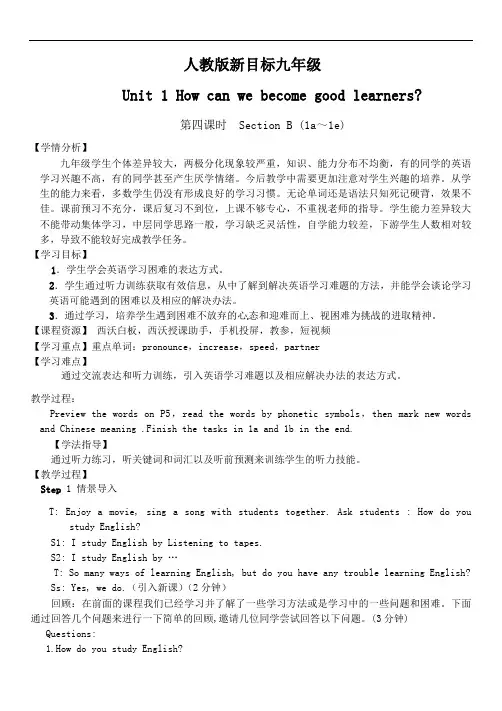
人教版新目标九年级Unit 1 How can we become good learners?第四课时Section B (1a~1e)【学情分析】九年级学生个体差异较大,两极分化现象较严重,知识、能力分布不均衡,有的同学的英语学习兴趣不高,有的同学甚至产生厌学情绪。
今后教学中需要更加注意对学生兴趣的培养。
从学生的能力来看,多数学生仍没有形成良好的学习习惯。
无论单词还是语法只知死记硬背,效果不佳。
课前预习不充分,课后复习不到位,上课不够专心,不重视老师的指导。
学生能力差异较大不能带动集体学习,中层同学思路一般,学习缺乏灵活性,自学能力较差,下游学生人数相对较多,导致不能较好完成教学任务。
【学习目标】1.学生学会英语学习困难的表达方式。
2.学生通过听力训练获取有效信息,从中了解到解决英语学习难题的方法,并能学会谈论学习英语可能遇到的困难以及相应的解决办法。
3.通过学习,培养学生遇到困难不放弃的心态和迎难而上、视困难为挑战的进取精神。
【课程资源】西沃白板,西沃授课助手,手机投屏,教参,短视频【学习重点】重点单词:pronounce,increase,speed,partner【学习难点】通过交流表达和听力训练,引入英语学习难题以及相应解决办法的表达方式。
教学过程:Preview the words on P5,read the words by phonetic symbols,then mark new words and Chinese meaning .Finish the tasks in 1a and 1b in the end.【学法指导】通过听力练习,听关键词和词汇以及听前预测来训练学生的听力技能。
【教学过程】Step 1 情景导入T: Enjoy a movie, sing a song with students together. Ask students : How do you study English?S1: I study English by Listening to tapes.S2: I study English by …T: So many ways of learning English, but do you have any trouble learning English?Ss: Yes, we do.(引入新课)(2分钟)回顾:在前面的课程我们已经学习并了解了一些学习方法或是学习中的一些问题和困难。
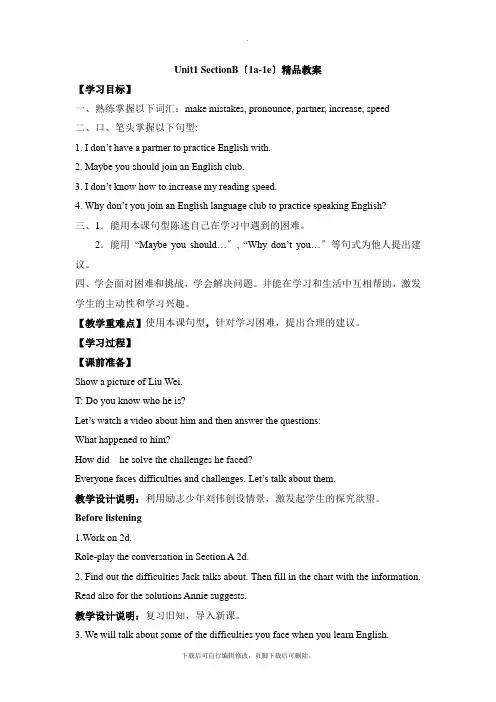
Unit1 SectionB〔1a-1e〕精品教案【学习目标】一、熟练掌握以下词汇:make mistakes, pronounce, partner, increase, speed二、口、笔头掌握以下句型:1. I don’t have a partner to practice English with.2. Maybe you should join an English club.3. I don’t know how to increase my reading speed.4. Why don’t you join an English language club to practice speaking English?三、1.能用本课句型陈述自己在学习中遇到的困难。
2.能用“Maybe you should…〞, “Why don’t you…〞等句式为他人提出建议。
四、学会面对困难和挑战,学会解决问题。
并能在学习和生活中互相帮助,激发学生的主动性和学习兴趣。
【教学重难点】使用本课句型,针对学习困难,提出合理的建议。
【学习过程】【课前准备】Show a picture of Liu Wei.T:Do you know who he is?Let’s watch a video about him and then answer the questions:What happened to him?How did he solve the challenges he faced?Everyone faces difficulties and challenges. Let’s talk about them.教学设计说明:利用励志少年刘伟创设情景,激发起学生的探究欲望。
Before listening1.Work on 2d.Role-play the conversation in Section A 2d.2. Find out the difficulties Jack talks about. Then fill in the chart with the information. Read also for the solutions Annie suggests.教学设计说明:复习旧知,导入新课。

UNIT 1How can we become good learners?Section B(1a—1e)第3课时设计说明教学反思本课时学习有关学习中遇到的困难及解决方法的对话。
教学时通过复习导入新课,然后让学生讨论在英语学习中擅长的一面及遇到的困难,过渡到1a与1b的活动中。
通过不同的任务对听力材料加以处理,让学生多维度地利用听力材料。
教学目标通过本课时的学习,让学生达成以下目标:1.知识目标(1) 单词:pronounce, increase, speed, review,partner(2) 短语:spoken English, 疑问词+动词不定式,make mistakes(in…)2.能力目标能谈论英语学习中遇到的困难及解决办法。
3.情感目标通过学习,培养学生遇到困难不放弃的心态和迎难而上的进取精神。
重点难点1.重点:掌握本课时中所涉及的重点单词、短语和用法。
2.难点:能够联系实际,运用“by +v.-ing”结构谈论自己的学习方法,并能为别人提供合理的建议。
教学准备PPT课件,1c,1d的录音教学过程Step 1Lead-inRevision:1. Retell the passage in Section A 3a.2. Wei Fen’s problems in learning English.3. Wei Fen’s solutions to the problems.Step 2 DiscussionGet the students to discuss:• Do you like English?Tell us what you are good at: English composition, handwriting, spoken English,reading, singing in English…• Do you think English is difficult?• What things are difficult for you?Step 3Work on 1aLearning English can be difficult. What things are difficult for you? Read the list. Check(√)the statements that are true for you.____ I can’t pronounce some of the words.____ I can’t always understand spoken English.____ I don’t know how to increase my reading speed.____ I can’t spell some English words.____ I often make mistakes in grammar.Step 4Work on 1bWhat other things are difficult for you? Make a list.1. I don’t know enough words to write well.Some other possible problems:2. I’m nervous when I try to speak English.3. I can’t understand English movies.4. I don’t understand native speakers of English.5. I want to read English books but I don’t know what to read.Step 5ListeningWork on 1c. Paul finds it difficult to learn English. Listen and complete the learning challenges he talks about.Challenges1. He can’t get the _________ right.2. He ________ a lot of new words.3. He can’t always _________ when people talk to him.4. He doesn’t get much ________ practice.Check the answers one by one.The answers are:1. pronunciation2. forgets3. understand4. writingWork on 1d. Listen again. Complete the solutions.Solutions1. _________ can help.2. He can always _________ in his notebook and review them from time to time.3. He can _________ to practice speaking.4. He should find a _________ to practice writing.Check the answers one by one.The answers are:1. Listening2. write the new words3. join an English language club4. pen palListen again and match the challenges with the solutions.Check the answers one by one.The answers are: 1. d 2. a 3. b 4. cListen again and pay attention to the following sentences.Get the students to have a summary.给他人提建议的常用句型:• Why don’t you do…?• Why not do…?• Maybe you should do…• You can/could do…• What/How about doing…?• You’d better do…Step 6Role-playRole-play conversations using the information in 1c and 1d. 1. A: I don’t have a partner to practice English with.B: Maybe you should join an English club.2. A: I can’t always understand when people talk to me.B:You can join an English language club to practice speaking. Step 7Language points1. I can’t always understand spoken English.spoken English 英语口语有些动词的过去分词可作该词的形容词:spoken口语的broken坏的, 碎的written书面的pieces of broken glass玻璃碎片written language书面语2. I don’t know how to increase my reading speed.how to increase my reading speed是“疑问词+动词不定式”结构,在该句中作宾语。

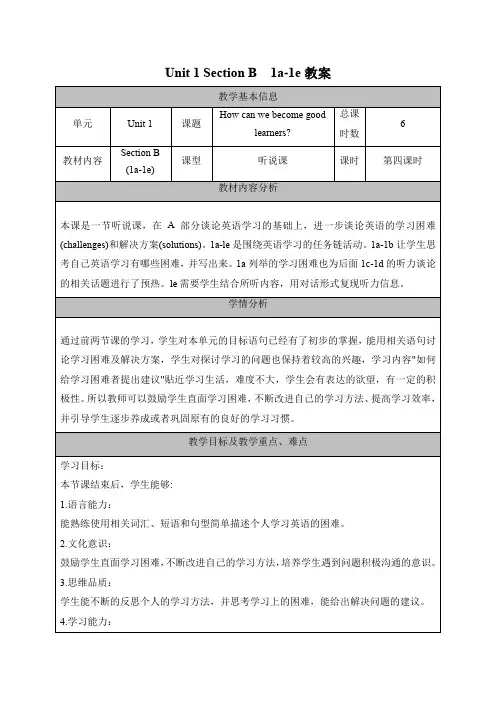
Unit 1 Section B 1a-1e教案教学基本信息单元Unit 1课题How can we become goodlearners?总课时数6教材内容Section B(1a-1e)课型听说课课时第四课时教材内容分析本课是一节听说课,在A部分谈论英语学习的基础上,进一步谈论英语的学习困难(challenges)和解决方案(solutions)。
1a-le是围绕英语学习的任务链活动。
1a-1b让学生思考自己英语学习有哪些困难,并写出来。
1a列举的学习困难也为后面1c-1d的听力谈论的相关话题进行了预热。
le需要学生结合所听内容,用对话形式复现听力信息。
学情分析通过前两节课的学习,学生对本单元的目标语句已经有了初步的掌握,能用相关语句讨论学习困难及解决方案,学生对探讨学习的问题也保持着较高的兴趣,学习内容"如何给学习困难者提出建议"贴近学习生活,难度不大,学生会有表达的欲望,有一定的积极性。
所以教师可以鼓励学生直面学习困难,不断改进自己的学习方法、提高学习效率,并引导学生逐步养成或者巩固原有的良好的学习习惯。
教学目标及教学重点、难点学习目标:本节课结束后,学生能够:1.语言能力:能熟练使用相关词汇、短语和句型简单描述个人学习英语的困难。
2.文化意识:鼓励学生直面学习困难,不断改进自己的学习方法,培养学生遇到问题积极沟通的意识。
3.思维品质:学生能不断的反思个人的学习方法,并思考学习上的困难,能给出解决问题的建议。
4.学习能力:能使用目标句型讨论英语学习中的困难和解决困难的方法,养成良好的学习习惯。
教学重点:1.本节课新单词、短语和重点结构句型。
pronounce, increase, speed, partnerincrease the reading speed, make mistakes, spoken English-I don't know how to increase my reading speed.-You should read more books and remember more words.I don't know enough words to write well.2.引导学生运用合适的策略和技巧,获取听力材料的细节信息,完成听力任务。
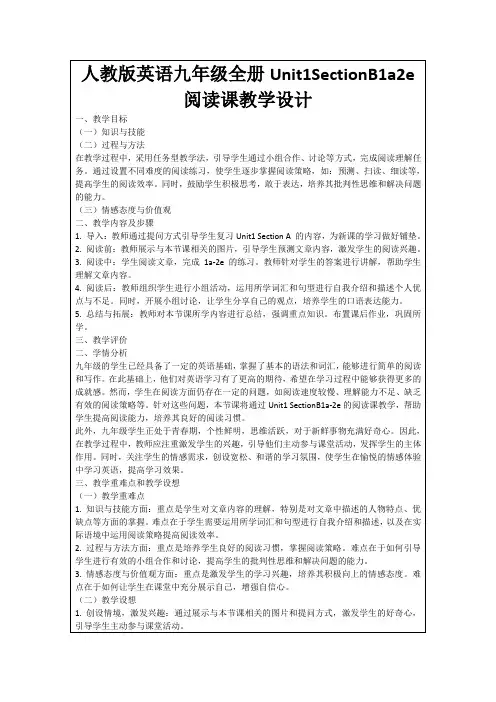
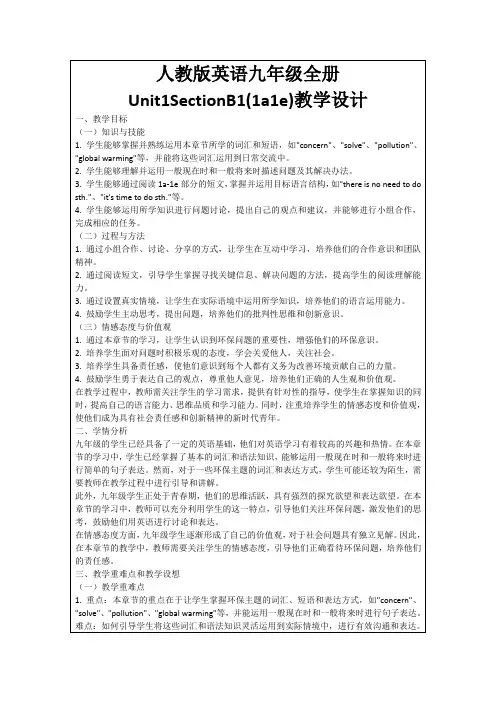

Unit1 SectionB〔la-1e〕优质课教案1教学目标一〕知识与技能1. 学习新单词pronounce,increase, speed, partner;学生能够谈论学英语时可能遇到的困难以及相应的解决方法;2. 培养学生听说技能。
二〕过程与方法:英语听力练习中,引导学生进展听前预测,听录音特定信息,在任务的驱动下学生进展自主学习与合作探究。
情景交际教学法贯穿课堂始终。
利用教学幻灯片、图片等来展开课堂Pair work,Goup work等活动,以本课目标语言为核心,设置不同活动,多层次地训练学生的听说能力。
三〕情感态度与价值观:1. 通过小组活动介绍学习方法,培养学生合作意识,增强学英语的信心;2. 培养学生遇到困难不放弃的心态.2学情分析本班局部学生懂得一些英语语言学习的根底方法,但是仍然有很多学生学习过程中有很多困扰。
而且大局部学生害怕用英语与别人交流。
本节课学生了解学习中的困难与解决方法,以便更好的学习英语。
3重点难点1. 掌握生词和本节课的语言目标2. 提高学生的听力和说的技能4教学过程导学环节设计Step 1 Leading-inAt first, free talk: Do you like English? Why or why not? Then Show my friend’s son difficulties in learning English, and then students give some advice.环节说明:课前的学生问答互动不仅让学生回忆了上节课的内容,引导学生大胆地说英语,而且还可以很自然地导入到本节课的内容学:英语的一些困难。
Step 2 Presentation1. 1a.教师课前根据1a的内容制作课件并把课件展示在电子白板上,列举出学生在英语学习中会遇到的问题:I can’t pronounce some of the words; I can’t always understand spoken English; I don’t know how to increase reading speed; I can’t spell some English words; I often make mistakes in grammar.引导学生根据课件所示的内容作答,也可以添加一些内容。
第四课时Section B (1a~1e)【学习目标】1.学生学会英语学习困难的表达方式。
2.学生通过听力训练获取有效信息,从中了解到解决英语学习难题的方法,并能学会谈论学习英语可能遇到的困难以及相应的解决办法。
3.通过学习,培养学生遇到困难不放弃的心态和迎难而上、视困难为挑战的进取精神。
【学习重点】重点单词:pronounce,increase,speed,partner【学习难点】通过交流表达和听力训练,引入英语学习难题以及相应解决办法的表达方式。
☞学习提示English isn't our mother language.It is very difficult for foreign learners.Which problems are there in your English learning?Task 1☞学习提示Preview the words on P5,read the words by phonetic symbols,then mark new words and Chinese meaning.Finish the tasks in 1a and 1b in the end.【学法指导】►pronounce作动词,意为“发音”,其名词形式为pronunciation,不可数。
Task 2☞学习提示Listen to the tape and finish the listening tasks in 1c on P5.Then listen again and finish listening tasks in 1d.Listen to the tape again and finish the chart.情景导入生成问题T:Do you remember the ways of learni ng English that we've learned in Sect ion A?Maybe you have many good ways to learn English,but have you ever had any problems with English?Now,let's look at 1a and check the statements that are true for you.Look at 1b.What other things are difficult for you?Make a list.自学互研生成能力Task 1Let's read new words and the phrases.1.I can read.(我会读)预习下列单词,争取自己能正确拼读。
Unit1 SectionB(1a-1e)教案
【教材版本与册数】新目标人教版九年级全一册
【单元名称】Unit 1 How can we become good learners?
【课时】Section B 1a-1e(第4课时)
【课型】Listening and Speaking(听说课)
【本课时教学设计】
教材版本:新目标册数:第5册年级:九年级单元:Unit 1 课型(课时):Section B 1a-1e 听说课
教材分析
【本单元话题】
本部分在Section
A谈论英语学习的基础上,在话题上从英语的学习困难及解决方案,拓展到优秀学习者的学习习惯;在语言上巩固了Section
A所学语言结构,丰富了与学习相关的话题词汇;在技能上将听说能力综合,突出阅读训练,由读促写;在策略上,引导学生关注优秀学生的学习方式,借鉴并用于自身;在情感上,鼓励学生直面学习困难,积极探索解决方案,不断改进自己的学习方法、提高学习效率。
【本单元重点掌握目标】
用“by + 动词-ing形式”结构来表达方式方法。
【教材内容拆分分析】
活动1a-1e是围绕英语学习的听说任务链活动。
1a-1b让学生思考自己英语学习有哪些困难,并写出来。
1a列
1/ 10
举的学习困难也为后面1c-1d的听力谈论的相关话题进行了预热。
1e需要结合所听内容,用对话形式复现听力信息。
【综合技能】
通过本单元的学习使学生学会谈论自己和别人的学习方式,巩固所学语言结构,丰富了与学习相关的话题词汇,引导学生关注优秀学生的学习方式,借鉴并用于自身。
教学目标语言知识目标:
1.熟练掌握下列词汇:pronounce increase speed partner
2掌握所涉重点句子
3.完成课本各听力题目。
情感态度价值观目标:
鼓励学生直面学习困难,积极探索解决方案,不断改进自己的学习方法、提高学习效率。
教学重难点教学重点:
熟练运用pronounce increase speed partner等目标词汇。
教学难点:
学生听力技能的培养。
学生通过熟练运用字典查阅生词及利用上下文确定单词释义来提高自身的学习能力。
建议教法情景交际法,任务型教学法
教学流程(详见相应教学设计)
1.本课时的目标设计清晰可操作,活动的设计紧扣目标要求并与目标达成一致。
2/ 10
3/ 10
Step 3 While- listening (听中)(15mins) 1)1c Paul finds it difficult to learn English. Listen
and complete .
Answers: pronunciation, forgets, understand
2) 1d Listen again. Complete the solutions.
3) listen again and read after it.
Answers: Listening ,write the new words, join an
English club,pen pal
2.能逐步掌握利用听中聚焦关键信
息和关注细节的策略,容易地完成听
力任务
3.通过听音模仿,加大语言输入量以
及强化语音语调学习
【提示:此处课堂上教师可让学生使
用优教同步学习卡进行抢答,
根据结果反馈,进行精准教学。
】
2.学生是否能用目标
词汇回答问题。
3.学生是否能通过听
音模仿朗读课文Challenges
1. He can’t get the _____________ right.
2 He ________ a lot of new words.
3. He can’t always __________ when people talk to him.
4. He doesn’t get much ________ practice.
Solutions
1. __________ can help.
2. He can always ____________________ in his notebook
and study them at home.
3. He can __________________________ to practice
speaking.
4. He should find a ________ to practice writing.
5/ 10
6/ 10
10/ 10。